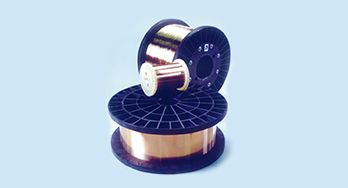 Phosphor Bronze wire is renowned for its durability and versatility in various industrial applications. At Little Falls Alloys, three primary grades—A, C, and E—exemplify this copper-based alloy’s range of properties and uses.
Phosphor Bronze wire is renowned for its durability and versatility in various industrial applications. At Little Falls Alloys, three primary grades—A, C, and E—exemplify this copper-based alloy’s range of properties and uses.
Grade A (C51000)
Grade A phosphor bronze is a staple in the non-ferrous spring industry. Known for its balanced mix of strength and formability, it stands between brass and beryllium copper. It offers a moderate price and good electrical conductivity, making it suitable for contact springs and diaphragms.
Composition: Predominantly copper, with 5.0% tin and 0.2% phosphorus.
Mechanical Properties: Offers an ultimate tensile strength of 110,000 PSI when cold rolled and an elongation rate of 2% at its thinnest.
Uses: It is ideal for springs, electrical connectors, and fasteners due to its excellent formability and resistance welding capabilities.
Grade C (C52100)
Grade C has a slightly higher tin content than Grade A, which allows it to work harden faster, increasing its tensile strength without sacrificing formability. This grade is beneficial for applications requiring additional strength and hardness.
Composition: Copper base with 8.0% tin and up to 0.35% phosphorus.
Mechanical Properties: In its annealed state, it has a tensile strength range of 53-68 KSI and can reach up to 150 KSI in its most complex form.
Uses: Suitable for high-strength applications such as bridge-bearing plates and heavy-duty electrical connectors. It is also commonly used for welding due to its color matching with other bronzes.
Grade E (C50700)
Grade E is notable for its excellent electrical conductivity and economical pricing. It does not contain zinc, preventing de-zincification, and is preferred for hot solder or tin coating processes.
Composition: Consists mainly of copper, with 1.75% tin.
Physical Properties: Has a melting range of 1900-1970°F and a density of .321 lb/cu.
Uses: Its superior conductivity makes it suitable for electronic connectors and other components where electrical efficiency is crucial.
Comparison and Selection
Strength and Hardness: Grade C is the strongest due to its high tin content, followed by Grade A and Grade E.
Electrical Conductivity: Grade E leads in conductivity, making it ideal for electrical applications, followed by Grade A and then Grade C.
Cost-Effectiveness: Grade E offers the most economical option suitable for large-scale applications requiring material efficiency.
Getting the Right Phosphor Bronze Wire
When selecting the appropriate grade of phosphor bronze—whether Grade A, C, or E— understanding the specific application requirements and design challenges is crucial for ensuring optimal performance and quality. Each grade offers unique strength, conductivity, and cost-effectiveness advantages, making the choice dependent on the operational demands and environmental conditions.

 Technical Data
Technical Data


